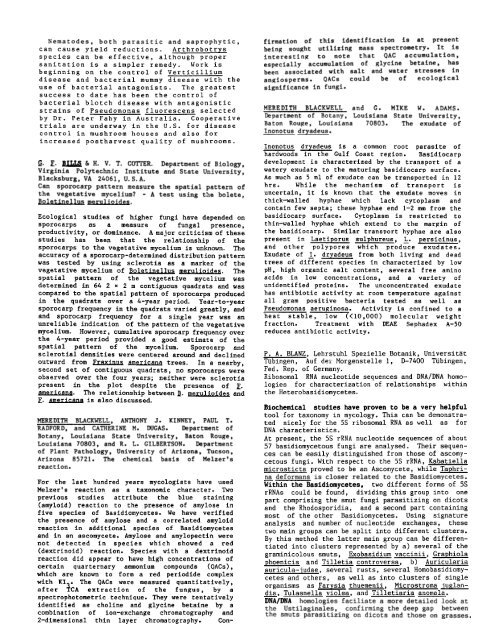1985 - Mycological Society of America
1985 - Mycological Society of America
1985 - Mycological Society of America
You also want an ePaper? Increase the reach of your titles
YUMPU automatically turns print PDFs into web optimized ePapers that Google loves.
Nematodes, both parasitic and saprophytic,<br />
can cause yield reductions. Arthrobotrys<br />
species can be effective, although proper<br />
sanitation is a simpler remedy. Work is<br />
beginning on the control <strong>of</strong> Verticillium<br />
disease and bacterial mummy disease with the<br />
use <strong>of</strong> bacterial antagonists. The greatest<br />
success to date has been the control <strong>of</strong><br />
bacterial blotch disease with antagonistic<br />
strains <strong>of</strong> Pseudomonas fluorescens selected<br />
by Dr. Peter Fahy in Australia. Cooperative<br />
trials are underway in the U.S. for disease<br />
control in mushroom houses and also for<br />
increased postharvest quality <strong>of</strong> mushrooms.<br />
6. E. & H. V. T. COTiER. Department <strong>of</strong> Biology,<br />
Virginia Polytechnic Institute and State University,<br />
Blacksburg, VA 24061, U. S. A.<br />
Can sporocarp pattern measure the spatial pattern <strong>of</strong><br />
the vegetative mycelium? - A test using the bolete,<br />
Boletinellus merulioida.<br />
Ecological studies <strong>of</strong> higher fungi have depended on<br />
sporocarps as a measure <strong>of</strong> fungal presence,<br />
productivity, or dominance. A major criticism <strong>of</strong> these<br />
studies has been that the relationship <strong>of</strong> the<br />
sporocarps to the vegetative mycelium is unknown. The<br />
accuracy <strong>of</strong> a sporocarp-determined distribution pattern<br />
was tested by using sclerotia as a marker <strong>of</strong> the<br />
vegetative mycelium <strong>of</strong> Boletinellus rerulioidea. The<br />
spatial pattern <strong>of</strong> the vegetative mycelium was<br />
determined in 64 2 x 2 q contiguous quadrats and was<br />
compared to the spatial pattern <strong>of</strong> sporocarps produced<br />
in the quadrats over a 4-year period. Year-to-year<br />
sporocarp frequency in the quadrats varied greatly, and<br />
and sporocarp frequency for a single year was an<br />
unreliable indication <strong>of</strong> the pattern <strong>of</strong> the vegetative<br />
mycelium. However, cumulative sporocarp frequency over<br />
the 4-year period provided a good estimate <strong>of</strong> the<br />
spatial pattern <strong>of</strong> the mycelium. Sporocarp and<br />
sclerotial densities were centered around and declined<br />
outward from Fraxinus americam trees. In a nearby,<br />
second set <strong>of</strong> contiguous quadrats, no sporocarps were<br />
observed over the four years; neither were sclerotia<br />
present in the plot despite the presence <strong>of</strong> E.<br />
emeric-. The relationship between B. peruliow and<br />
E. meric- is also discussed.<br />
MEREDITH BLACKWELL, ANTHONY J. KINNEY, PAUL T.<br />
RADFORD, and CATHERINE M. DUGAS. Department <strong>of</strong><br />
Botany, Louisiana State University, Baton Rouge,<br />
Louisiana 70803, and R. L. GILBERTSON. Department<br />
<strong>of</strong> Plant Pathology, University <strong>of</strong> Arizona, Tucson,<br />
Arizona 85721. The chemical basis <strong>of</strong> Melzer's<br />
reaction.<br />
For the last hundred years mycologists have used<br />
Melzer's reaction as a taxonomic character. Two<br />
previous studies attribute the blue staining<br />
(amyloid) reaction to the presence <strong>of</strong> amylose in<br />
five species <strong>of</strong> Basidiomycetes. We have verified<br />
the presence <strong>of</strong> amylose and a correlated amyloid<br />
reaction in additional species <strong>of</strong> Basidiomycetes<br />
and in an ascomycete. Amylose and amylopectin were<br />
not detected in species which showed a red<br />
(dextrinoid) reaction. Species with a dextrinoid<br />
reaction did appear to have high concentrations <strong>of</strong><br />
certain quarternary ammonium compounds (QACs),<br />
which are known to form a red periodide complex<br />
with KI The QACs were measured quantitatively,<br />
after &A extraction <strong>of</strong> the fungus, by a<br />
spectrophotometric technique. They were tentatively<br />
identified as choline and glycine betaine by a<br />
combination <strong>of</strong> ion-exchange chromatography and<br />
2-dimensional thin layer chromatography. Con-<br />
firmation <strong>of</strong> this identification is at present<br />
being sought utilizing mass spectrometry. It is<br />
interesting to note that QAC accumulation,<br />
especially accumulation <strong>of</strong> glycine betaine, has<br />
been associated with salt and water stresses in<br />
angiosperms. QACs could be <strong>of</strong> ecological<br />
significance in fungi.<br />
MEREDITH BLACKWELL and G. MIKE W. ADAMS.<br />
Department <strong>of</strong> Botany, Louisiana State University,<br />
Baton Rouge, Louisiana 70803. The exudate <strong>of</strong><br />
Inonotus dryadeus.<br />
Inonotus dryadeus is a common root parasite <strong>of</strong><br />
hardwoods in the Gulf Coast region. Basidiocarp<br />
development is characterized by the transport <strong>of</strong> a<br />
watery exudate to the maturing basidiocarp surface.<br />
As much as 5 ml <strong>of</strong> exudate can be transported in 12<br />
hrs. While the mechanism <strong>of</strong> transport is<br />
uncertain, it is known that the exudate moves in<br />
thick-walled hyphae which lack cytoplasm and<br />
contain few septa; these hyphae end 1-2 mm from the<br />
basidiocarp surface. Cytoplasm is restricted to<br />
thin-walled hyphae which extend to the margin <strong>of</strong><br />
the basidiocarp. Similar transport hyphae are also<br />
present in Laetiporus sulphureus, d. persicinus,<br />
and other polypores which produce exudates.<br />
Exudate <strong>of</strong> i. dtiadeus from both living and dead<br />
trees <strong>of</strong> different species in characterized by low<br />
pH, high organic salt content, several free amino<br />
acids in low concentrations, and a variety <strong>of</strong><br />
unidentified proteins. The unconcentrated exudate<br />
has antibiotic activity at room temperature against<br />
all gram positive bacteria tested as well as<br />
Pseudomonas aeru~inosa. Activity is confined to a<br />
heat stable, low (
















